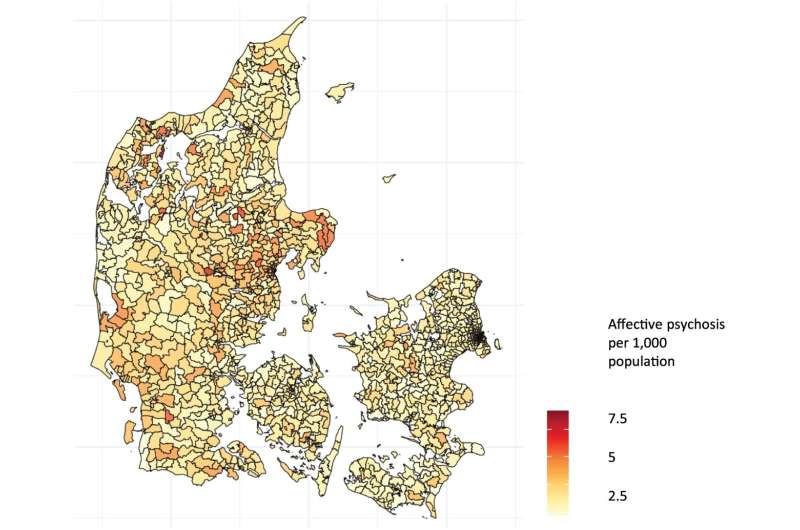Cumulative prevalence of affective psychosis by parish in the study cohort. Credit: Schizophrenia Research (2022). DOI: 10.1016/j.schres.2022.05.015
A first-of-its kind study published in Schizophrenia Research looked at how demographic factors might play a different role in the development of non-affective psychosis (e.g. schizophrenia) when compared to affective psychosis (e.g., bipolar disorder).
Previous research has discovered that rates of some severe mental illness conditions known as non-affective psychoses, such as schizophrenia, will vary depending on geographical location. This contrasts to affective psychoses like bipolar disorder, which have not shown this geographical variation, despite sharing many other features.
This research was built on previous findings from Dr. Peter Schofield looking at the role of the neighborhood in the development of severe mental illness.
The authors wanted to explore this topic further by analyzing medical data for the entire population of Denmark. Specifically, they looked at the neighborhood that people lived in when they were 15 years old and their subsequent medical history i.e. the probability that people developed either non-affective psychosis (schizophrenia) or affective psychosis (bipolar disorder).
Results showed that where someone lived as a 15-year-old was a big influence on the rates of subsequent conditions for both non-affective and affective psychosis. This was also observed with specific demographic categories, with ethnic density found to impact the rates of both affective and non-affective psychoses in individuals from ethnic minority backgrounds.
However, these similarities were not seen when analyzing other demographic factors. When looking at the impact of urbanization, an association was only established with non-affective psychosis. The most urban neighborhoods were associated with a substantial increase in rates of non-affective psychosis compared to less urban neighborhoods, but no comparable difference was found for affective psychosis.
These data could reflect differences in how non-affective and affective psychosis develop, and the authors note that future research on psychotic disorders could benefit from further analysis of the effects of different risk factors on the development of these disorders.
More information: Peter Schofield et al, A comparison of neighbourhood level variation and risk factors for affective versus non-affective psychosis, Schizophrenia Research (2022). DOI: 10.1016/j.schres.2022.05.015
Provided by King's College London























